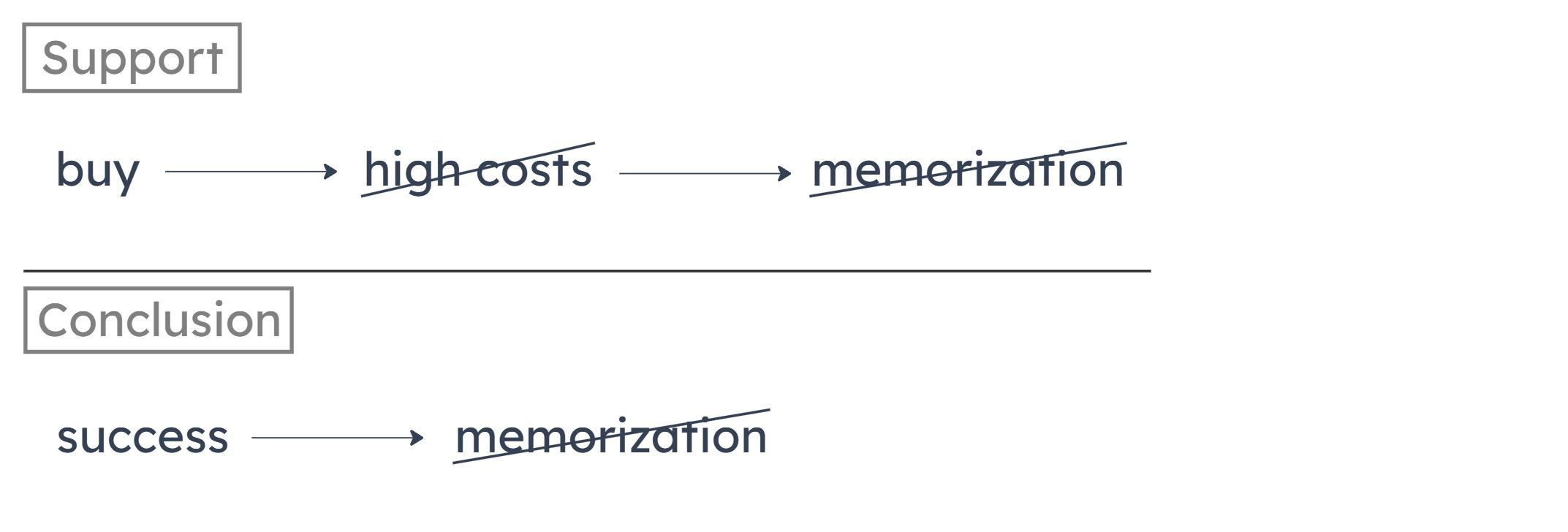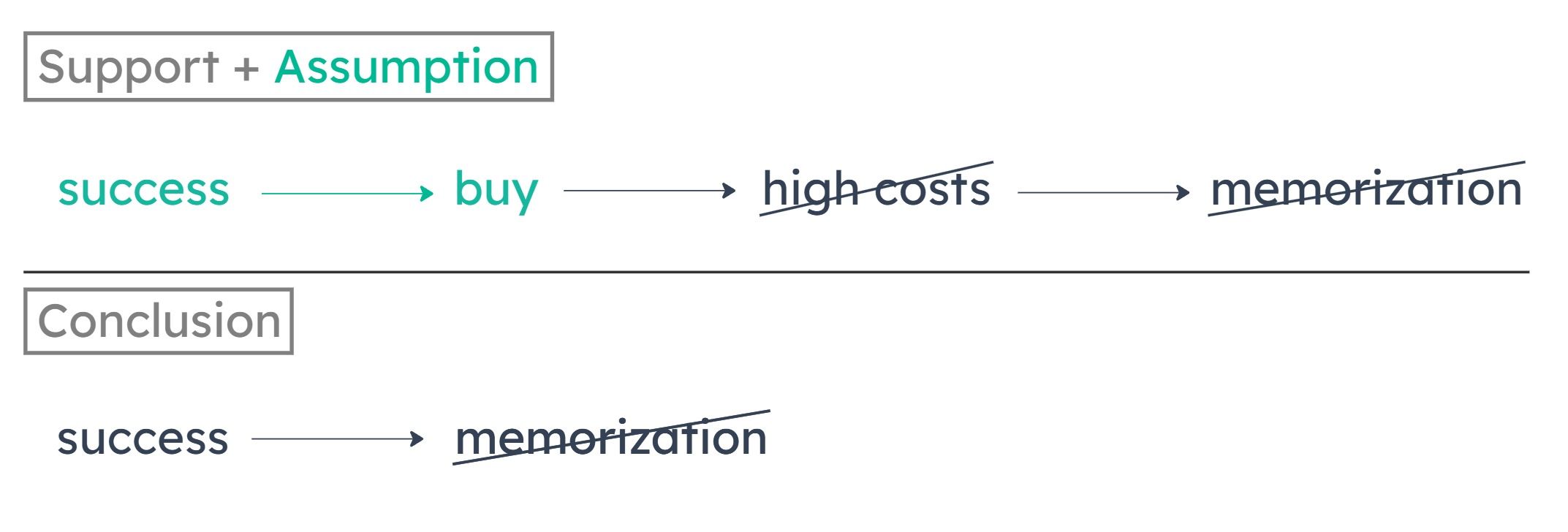LSAT 103 – Section 3 – Question 21
LSAT 103 - Section 3 - Question 21
September 1998You need a full course to see this video. Enroll now and get started in less than a minute.
Target time: 1:13
This is question data from the 7Sage LSAT Scorer. You can score your LSATs, track your results, and analyze your performance with pretty charts and vital statistics - all with a Free Account ← sign up in less than 10 seconds
| Question QuickView |
Type | Tags | Answer Choices |
Curve | Question Difficulty |
Psg/Game/S Difficulty |
Explanation |
|---|---|---|---|---|---|---|---|
| PT103 S3 Q21 |
+LR
| Sufficient assumption +SA Conditional Reasoning +CondR Link Assumption +LinkA | A
7%
163
B
10%
162
C
71%
169
D
3%
155
E
8%
160
|
153 160 167 |
+Hardest | 148.537 +SubsectionMedium |
J.Y.’s explanation
You need a full course to see this video. Enroll now and get started in less than a minute.
Summary
The argument concludes that in order to be successful, the software cannot demand memorization of unfamiliar commands. This is based on the following two premises:
If training costs are high, prime purchasers of the software won’t buy it.
If a software demands memorization of unfamiliar commands, then the training costs are high.
If training costs are high, prime purchasers of the software won’t buy it.
If a software demands memorization of unfamiliar commands, then the training costs are high.

Missing Connection
We want to reach the conclusion that if a software demands memorization of unfamiliar commands, it won’t be successful. “Won’t be successful” is a new concept in the conclusion; the premises don’t tell us what leads to lack of success.
But we do know from the two premises together that if a software demands memorization of unfamiliar commands, the prime purchasers won’t buy it.
If we learn that “prime purchasers won’t buy” establishes “unsuccessful,” that will establish that if a software demands memorization of unfamiliar commands, it won’t be successful. In other words, we want to learn that in order to be successful, a software needs prime purchasers to buy it.
But we do know from the two premises together that if a software demands memorization of unfamiliar commands, the prime purchasers won’t buy it.
If we learn that “prime purchasers won’t buy” establishes “unsuccessful,” that will establish that if a software demands memorization of unfamiliar commands, it won’t be successful. In other words, we want to learn that in order to be successful, a software needs prime purchasers to buy it.
A
If most prime purchasers of computer software buy a software product, that product will be successful.
(A) establishes what is sufficient for a software product to be successful. But we’re trying to establish what’s sufficient for a software product to be UNsuccessful. Or, you could also say that we’re looking for what’s necessary for the product to be successful. Learning what’s sufficient for success doesn’t prove what’s necessary for success.
B
Commercial computer software that does not require users to memorize unfamiliar commands is no more expensive than software that does.
(B) compares the expense of different kinds of software. But it doesn’t tell us anything about what’s required for success, or what’s sufficient to lead to lack of success.
C
Commercial computer software will not be successful unless prime purchasers buy it.
(C) establishes that in order for a software product to be successful, its prime purchasers must buy it. Since we know from the premises that if a product demands memorization of unfamiliar commands, prime purchasers won’t buy it, adding (C) now establishes that if a product demands memorization of unfamiliar commands, it won’t be successful.

D
If the initial cost of computer software is high, but the cost of training users is low, prime purchasers will still buy that software.
(D) doesn’t tell us anything about what’s required for success, or what’s sufficient to lead to lack of success.
E
The more difficult it is to learn how to use a piece of software, the more expensive it is to teach a person to use that software.
(E) doesn’t tell us anything about what’s required for success, or what’s sufficient to lead to lack of success.
Take PrepTest
Review Results
LSAT PrepTest 103 Explanations
Section 1 - Logical Reasoning
- Question 01
- Question 02
- Question 03
- Question 04
- Question 05
- Question 06
- Question 07
- Question 08
- Question 09
- Question 10
- Question 11
- Question 12
- Question 13
- Question 14
- Question 15
- Question 16
- Question 17
- Question 18
- Question 19
- Question 20
- Question 21
- Question 22
- Question 23
- Question 24
- Question 25
- Question 26
Section 2 - Logical Reasoning
- Question 01
- Question 02
- Question 03
- Question 04
- Question 05
- Question 06
- Question 07
- Question 08
- Question 09
- Question 10
- Question 11
- Question 12
- Question 13
- Question 14
- Question 15
- Question 16
- Question 17
- Question 18
- Question 19
- Question 20
- Question 21
- Question 22
- Question 23
- Question 24
- Question 25
Section 3 - Logical Reasoning
- Question 01
- Question 02
- Question 03
- Question 04
- Question 05
- Question 06
- Question 07
- Question 08
- Question 09
- Question 10
- Question 11
- Question 12
- Question 13
- Question 14
- Question 15
- Question 16
- Question 17
- Question 18
- Question 19
- Question 20
- Question 21
- Question 22
- Question 23
- Question 24
- Question 25
Leave a Reply
You must be logged in to post a comment. You can get a free account here.